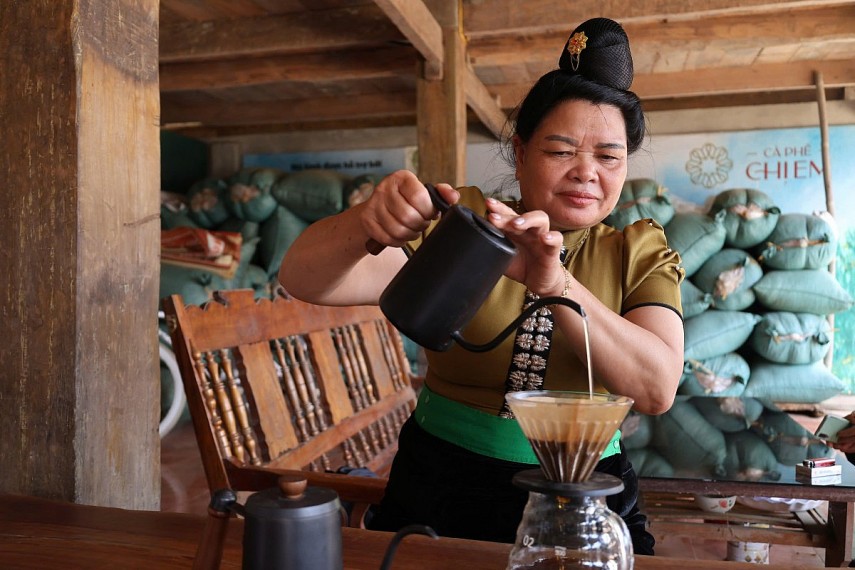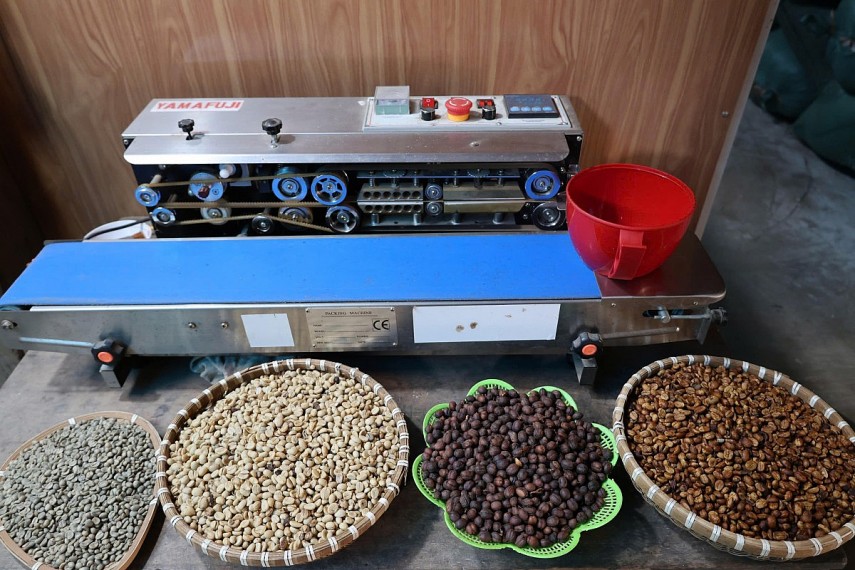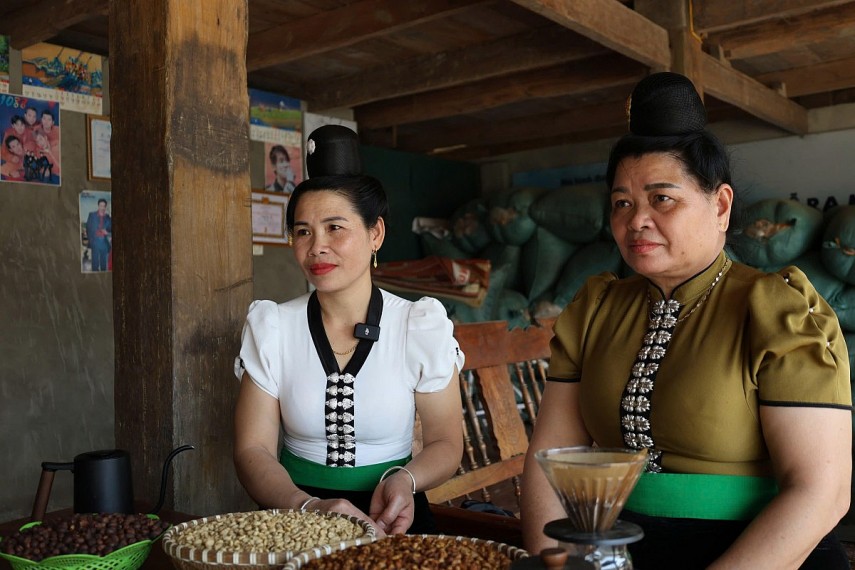Muong Ang Coffee - The “Green Gold” on majestic highlands
Stories behind coffee beans
After years of development, coffee has not only been an agricultural crop, but also brought material prosperity to the local people. Currently, Muong Ang District is home to more than 3,000 hectares of coffee stretching across villages like Ang Nưa, Ang Cang, and Ang To, providing stable income for thousands of households, primarily the Thai, H’mong, and Kho Mu ethnic minorities, and also gradually elevating the Muong Ang coffee brand in the market.
Tong Thi Noong who lives in Na Luong Village, Ang Nua Commune, the owner of the “Cà phê Chị Em” or “Sisters’ Coffee” brand, said, “Coffee is not just an agricultural product, it is a livelihood and a source of hope for my family and many households here, especially ethnic minorities.” Establishing the “Sisters’ Coffee” brand has not only brought stable income for her family, but has created jobs for the local ethnic minorities.
 |
| Tong Thị Noong from the “Sisters’ Coffee” brand - photo: Ngọc Hoa |
Talking about her journey to success, Tong Thi Noong explained that the “Sisters’ Coffee” brand was developed by a group of four Thai ethnic sisters. They all come from families of difficult circumstances, and came up with the idea of creating the group to buy coffee beans from local farmers, process them, and sell them in the market.
This was a bold decision since they were all familiar only with farming, without any business experience, and had to learn everything from the beginning, such as speaking fluently in the official Vietnamese language, studying farming techniques and how to care for and harvest coffee, as well as acquiring knowledge in business.
At the beginning, the group only harvested and sold green coffee beans to some companies in Hanoi. However, since 2019, they have produced finished coffee products under the “Sisters’ Coffee” brand. The four sisters spent their loaned capital on building greenhouses to dry the coffee beans and purchased more equipment for roasting and grinding. Their product is mainly processed coffee made by traditional handcrafting methods, with support from machines. The “Sisters’ Coffee” is pure, clean coffee with a natural, rich, and aromatic flavor.
Currently, the “Sisters’ Coffee” brand processes about 35 tonnes of fresh coffee each year, equivalent to 5 to 5.5 tonnes of finished products, and is gradually establishing its brand in the market. However, Tong Thi Noong shared that to expand the market, there are still many challenges to overcome.
“Besides purchasing coffee directly from farmers, we are always concerned about how to expand the market and make the coffee of ethnic minorities more well-known, especially through e-commerce platforms. However, selling online is an arduous journey. We have tried selling our products on Facebook and Zalo, but encountered many challenges, from promoting the products to approaching customers effectively,” she said.
 |
| Arabica coffee in Na Luong Village are grown at the altitude from 700 to 1,700 meters above sea level Photo: Ngoc Hoa |
Improving livelihoods for ethnic minorities
Recognizing the important role of coffee plants in the local socioeconomic development, the Muong Ang District People’s Committee has formulated strategic directions to maintain and expand coffee cultivation areas to around 5,000 hectares by 2030.
In an interview with the Newspaper of Industry and Trade, Nguyen Phung Thong, Deputy Head of the Division of Agriculture and Rural Development in Muong Ang District, shared that over the past time, local authorities and relevant units have identified coffee as a key crop that helps ethnic minorities improve their livelihoods. Currently, Muong Ang has over 3,000 hectares of coffee, with 2,193 hectares for harvest and 822 hectares being newly-grown.
“As for the coffee plant, Muong Ang aims to ensure both quantity and quality. Currently, the stable coffee area is about 2,000 hectares, yielding 15 to 20 tonnes of fresh coffee cherries per hectare per season. In recent years, the district has harvested between 15,000 and 20,000 kilograms of fresh coffee cherries. This has contributed to increasing income and creating jobs for hundreds of local workers,” Thong said.
To ensure sustainable coffee growth, more solutions are needed to improve product quality, strengthen connections with processing factories, and expand domestic and international markets. Currently, Muong Ang is also working on establishing geographical indications and regional codes to enhance product value and expand export markets. Now, the necessary documentation and procedures are almost complete, and geographical indication certification and regional codes will be granted soon.
In the future, Muong Ang will continue to support the local growers to create sustainable jobs and improve income, focusing on developing coffee-growing areas and enhancing the quality of coffee plants. Accordingly, the local People’s Committee will continue to support ethnic minorities in deep processing, adding value to the product not only in fresh coffee, but also by investing in processing technology and machinery.
 |
| Tong Thị Hoai (left) and Tong Thị Noong (right) share their stories behind the coffee beans Photo: Ngọc Hoa |
The district’s authorities have been implementing policies to support coffee growers and businesses in producing and selling coffee, in terms of offering favorable loans and training programs to improve the quality of human resources. However, to achieve better results, Nguyen Phung Thong hopes for further support from authorities of different levels in replanting coffee, providing capital for improving infrastructure and irrigation systems to ensure higher-quality products.
It can be said that the coffee plant is not only the main source of income, but also a driving force that helps ethnic minorities in Muong Ang improve their lives and escape poverty sustainably. With the support of the local authorities and hardwork of the growers, it is believed that in the near future, Muong Ang coffee will become a strong brand, expanding both in domestic and international markets.
| The growing demand for coffee is motivating Muong Ang local people to increase long-term investment in coffee cultivation. The district has been developing sustainable organic coffee farming models to provide clean, high-quality products, which not only increase product value, but also contribute to environmental protection, reducing the use of chemical fertilizers and pesticides, and meeting the green consumption trend. |
Article URL: https://ven.congthuong.vn/muong-ang-coffee-the-green-gold-on-majestic-highlands-56980.html
Print ArticleCopyrights of Vietnam Economic News, All rights reserved VEN.VN | VEN.ORG.VN
